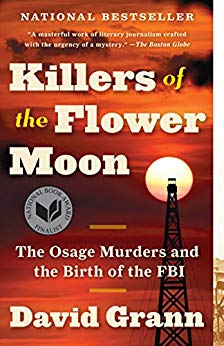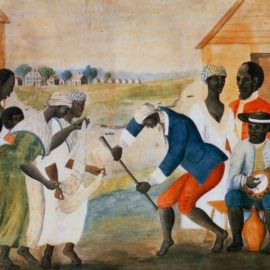

This article is an excerpt from the Shortform summary of "Killers of the Flower Moon" by David Grann. Shortform has the world's best summaries of books you should be reading.
Like this article? Sign up for a free trial here .
How did guardianship laws allow people to commit theft? What role did they play in the Osage Reign of Terror?
Guardianship laws declared some adult Osage Tribe members incompetent so that “guardians” could control their money. This arrangement ultimately played a role in an unthinkable tragedy.
Read more to learn about guardianship laws and the Osage murders.
New Oil Wealth for the Osage
The story of the Osage guardianship laws starts in 1897, when oil was discovered in Osage County, Oklahoma. The Osage Indians were suddenly rich beyond their wildest dreams. The total tribal income from oil leases ran into tens of millions.
What had once been a forgotten corner of the Great Plains overnight became a focal point of the American economy. Every three months when new Osage leases became available for auction, the major oil trusts of the day flocked to the county to bid, often bribing officials of the U.S. Department of the Interior to claim the most promising leases. Leases on individual tracts could climb as high as $2 million. At one auction, the oil companies bid a collective $14 million. In 1923 alone, the Osage drew an income of more than $30 million (more than $400 million in inflation-adjusted figures).
As owners of the mineral rights to the oil that lay beneath their lands, the Osage gained unimaginable wealth from these bidding wars. With the introduction of guardianship laws, they would soon be faced with a slew of petitions to have the Osage declared legally incompetent adults.
The tribal leadership instituted a headright system, under which each member of the Osage Nation was entitled to annual royalties from the oil production. Although individuals could sell their surface land, there was no right to buy or sell headrights. This ensured tribal control of the oil wealth.
Each member was allotted an equal share, providing a steady and lucrative income. Not all Osage were happy about the new wealth, however. Many, particularly the elders, believed that the influx of oil money would lead to the erasure of the traditional Osage way of life, creating a moral and spiritual void that could never be filled by material wealth. When the checks stopped coming, these elders warned, the Osage would be left with nothing. It would be sooner than they thought; the white residents were already planning to impose legal guardianship for adults to access Osage money.
The Guardianship Laws
Unfortunately, this oil wealth came at a terrible price. The wealth of the Osage attracted the jealousy and greed of some whites in Oklahoma who resented people they perceived as being their cultural and racial inferiors getting rich for simply having the good fortune to own land above a massive oil deposit.
The popular press at the time nurtured these sentiments by portraying members of the tribe as lazy, indolent, ignorant, un-thrifty, and undeserving of their wealth. Although these stories treated Osage wealth as a national scandal, they often wildly exaggerated the actual wealth that most Osage families enjoyed. The hard work and intelligence of white people, argued this racist narrative, was making the oil fields profitable, while the Osage were merely profiting while contributing nothing. The press played upon the racial resentments of white Americans by running stories detailing the supposedly extravagant lifestyles of the Osage, complete with expensive cars, lustrous jewelry, and exotic travel. Journalists made particular hay of the fact that some Osage even dared to have white servants in their employ. For white people, the idea of imposing legal guardianship for adults was a solution that would also make them wealthy.
Federal law, reflecting the pervasive racist attitudes of the time, did not deem the Osage to be fully competent to enjoy the fruits of their wealth. In 1921, Congress mandated that full-blooded Osage were to have their assets “protected” by court-appointed guardians, usually drawn from the ranks of local white attorneys, politicians, merchants, and bankers. They soon began declaring the Osage legally incompetent adults.
The rationale for this paternalistic policy was that the Osage were seen as childish, helpless people who could not be trusted to manage their own financial affairs. Left to their own devices, supporters of this policy argued, the Osage would squander their wealth on foolish and impulsive purchases. Worse, the decision to subject an Osage to the burden of guardianship was nearly always racially based—full-blooded members of the tribe were virtually guaranteed to have a guardian; those of mixed ancestry rarely were. This was one of the reasons that full-blooded Osage often sought white spouses—because their mixed-ancestry children would be more likely to be able to control their own assets.
Under legal guardianship for adults, a guardian had full control of the financial resources of an Osage—they could restrict their income from the headright, allowing them to live only on a pittance. The Osage were not free to spend their own money, as federal law restricted them from withdrawing more than a few thousand dollars per year. This had the result of keeping many of them in day-to-day poverty, despite being wealthy on paper. The Osage had no recourse to prevent this loss of financial autonomy.
The guardianship laws system also provided ample opportunities for corruption and graft. While some guardians certainly took their positions as financial stewards seriously, many others used the position as an opportunity to embezzle and defraud the Osage. As a guardian, one could use Osage money to purchase goods at one’s own business (ostensibly on behalf of their Osage wards) at inflated prices; or direct their Osage wards to only give their business to certain banks and stores, from which the guardian would receive a kickback; or borrow money cheaply from white creditors only to lend it back to their Osage victims at usurious interest rates. The financial pillaging of Osage families, in some cases, even resulted in the starvation deaths of infants and children. Before 1925, the government estimated that guardians had swindled the Osage out of a collective $8 million.
The practice of exploiting the Osage was so widespread and so deeply embedded in the culture of this part of Oklahoma that whites simply described it as “the Indian business.” Swarms of unscrupulous whites descended on Osage County, eager to take advantage of the opportunities for pilfery. These white guardians didn’t see what they were doing as acts of criminal fraud—robbing the Osage was just another way of making a living.
The guardianship laws were essentially a legal way for some residents of Osage to steal from the Osage Indians. By declaring them legally incompetent adults, others gained access to their wealth.

———End of Preview———
Like what you just read? Read the rest of the world's best summary of David Grann's "Killers of the Flower Moon" at Shortform .
Here's what you'll find in our full Killers of the Flower Moon summary :
- How the Osage tribe had vast oil wealth, but had it seized by their murderous neighbors
- The brutal and unresolved murders of Osage Native Americans
- The complicated history of the FBI in profiting from the Osage murders






